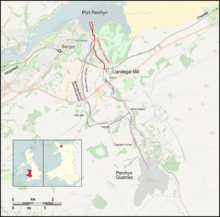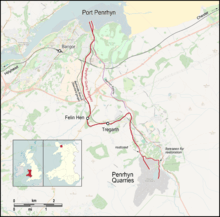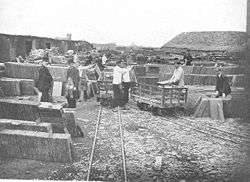Penrhyn Quarry Railway
|
Loading slates into slate waggons at Penrhyn Quarry, c. 1913 | |
| Locale | Wales |
|---|---|
| Dates of operation | 1798–1962 |
| Successor | Abandoned |
| Track gauge | 1 ft 10 3⁄4 in (578 mm) |
| Previous gauge | 2 ft 1⁄2 in (622 mm) (until 1879) |
| Headquarters | The Quarry Office, Port Penrhyn, Bangor[1] |
The Penrhyn Quarry Railway first opened in 1798 as the Llandegai Tramway; it became the Penrhyn Railway in 1801 although on a different route. Constructed to transport slate from Lord Penrhyn's slate quarries at Bethesda to Port Penrhyn at Bangor, Wales, the railway was around six miles (9.7 km) long and used a gauge of 1 ft 10 3⁄4 in (578 mm). The line was one of the oldest narrow gauge railways in the world. It closed on 24 July 1962, being lifted in 1965 when the track was sold to the Ffestiniog Railway.[2][3]
In 2012, the first section of the railway was restored by Penrhyn Quarries Ltd. and further sections are planned. Events are held each year on the restored section on the line, by Felin Fawr Cyf and PQR Engineering Ltd.
History
Llandegai Tramway (1798–1831)

The earliest predecessor to the Penrhyn Quarry Railway was the one mile (1.6 km) long 2 ft 1⁄2 in (622 mm) gauge Llandegai Tramway which was built in 1798. The tramway was connected to a local flint mill that ground clay and chert into flints. These were transported to Porth Penrhyn on the coast by the tramway,[4] which was one of the earliest overground railways in Britain. It included two balanced gravity inclines one from the floor of the Cegin valley near Llandegai to the hills above Bangor, the other dropping from there to the mill. Both inclines used vertically mounted winding drums.
Penrhyn Railway (1801–1878)

The success of the Llandegai Tramway encouraged the owners of the Penrhyn quarry to consider a similar tramway from their slate quarry to Porth Penrhyn. The plan subsumed the existing tramway into a longer railroad that connected Bethesda to the sea.
Construction started on 2 September 1800, relaying and extending the Llandegai Tramway, with the first slate train traveling on 25 June 1801. The new railway was also 2 ft 1⁄2 in (622 mm) gauge. The connection to the Llandegai flint mill continued to be used until 1831. The railroad was operated by horse power along with gravity and three balanced inclines – "Port" (sometimes called "Marchogion") near Llandegai, which was inherited from the Llandegai Tramway, "Dinas" north east of Tregarth and "Cilgeraint" a short distance north of Coed-y-Parc workshops in Bethesda. The longest extended for 220 yards. With hindsight this seems hard work, but the overall gain was remarkable, shown not least by the cost of transport falling from 4 shillings per ton to 1 shilling[5]
Penrhyn Quarry Railway (1878–1962)

By the early 1870s the Penrhyn Quarry Railway was no longer able to keep up with the output of the Penrhyn quarry. By 1874 the decision had been made to replace the railroad with a steam locomotive worked railway without rope-hauled inclines. Steam locomotives had already been introduced with great success on the quarry's internal railway system and at the nearby Dinorwic Quarry. The Ffestiniog Railway's example had shown that running a 2 ft gauge line for several miles from quarry to sea was perfectly feasible, and that company's Charles Easton Spooner was retained to survey and map possible routes to the port. The Penrhyn directors saw every reason not to follow the Padarn Railway's example and build a main line built to a gauge of 4 ft, joining lines in its quarries to lines in its dock both at a much narrower gauge. All Penrhyn tracks were of the same narrow gauge, so no costly and inefficient internal trans-shipments were needed.[6]
At the end of 1875 the first "mainline" locomotive was delivered to Port Penrhyn and moved to the quarry workshops at Coed y Parc. The railroad was converted into the new railway in five stages from 1877 to 1878.
Heading seawards (northwards) from the quarry at Bethesda the first (Cilgeraint) incline was bipassed by building an almost parallel straight line at a gentler end-to-end gradient whose foot was some distance north of the foot of the incline. A similar approach was not feasible for the other two inclines, so the traditional approach was taken – to increase the length of the line to spread the grade. The old route was retained to the head of the Dinas Incline where the new line swung through 180 degrees in a horseshoe bend, thereby changing from heading northeast to southwest. It then swung past a new halt at Tregarth before swinging northwards again past a new halt at Felin Hen, whereafter the line headed more or less straight for Port Penrhyn, meeting the original alignment below the foot of the Marchogion Incline.
The main line's primary purpose was to carry finished slates and Fullersite (powdered slate)[7][8] to Port Penrhyn where they were loaded onto ships or, from February 1852 when the Chester and Holyhead Railway opened its Port Penrhyn Branch,[9][10] onto standard gauge trains.[11] The ships and standard gauge trains took the products to national and international markets. Secondary traffic consisted of slate materials which were finished at workshops at Port Penrhyn into bitumen blocks and, notably, writing slates on which the port had a British near-monopoly in the 1930s.[12][13] Paying backloads were few, but sufficient coal was brought from the port to the quarries to warrant the company buying a fleet of 50 coal wagons. The line also carried internal user traffic such as spare parts. The intermixing of standard and narrow gauge lines at the port produced some remarkable pointwork.[14][15]
.jpg)
Lord Penrhyn had his own saloon coach,[16] which has survived into preservation.[17] An example of the second type of passenger vehicle – an Incline Carriage – has survived in the Penrhyn Castle Railway Museum. It was intended for conveying visitors and guests round the quarry itself, having inclined seats for comfort when travelling up and down inclines between levels.[18]
Workmen's trains were provided,[19] along with specials for visitors and dignitaries, but the railway never provided a public passenger service.[20] The quarrymen's carriages were unsprung and open to the elements, having neither roofs nor doors.[21] In the frequent event of rain and cold passengers usually covered themselves with sacks to keep out the worst. Each carriage could carry 24 quarrymen "at a pinch". The carriages resembled enlarged versions of many used on garden railways in fine weather.[22] 16 of these were built in two batches between 1878 and 1908, each bore a single letter in the series A to P. The service was withdrawn on 9 February 1951,[23] rendering the carriages redundant. Seven survived, six were given or sold to the Talyllyn Railway where they were modified[24] or cannibalised to such an extent that no Penrhyn bodies survive there. The seventh survivor was acquired by the Penrhyn Castle Railway Museum,[25] where it remained on view in 2016. Contradicting this to a degree is the Moseley Railway Trust which has carriage "O", which came into their hands after a long tour of various preservation sites, starting with Bressingham Steam and Gardens.[26] The trust has also built a replica of carriage "H".[27]
Restoration
.jpg)
Penrhyn Quarries Ltd completed the restoration of a section of the original railway at Felin Fawr, Bethesda in 2012 and returned 1909 Hunslet (Leeds) built locomotive 'George Sholto' from Norfolk for a day to commemorate fifty years since the railway closed. The section of restored railway is approximately one-fifth mile (0.3 km) in length and referred to as phase one, between Coed y Parc bridge (Felin Fawr) (grid ref. SH 615662) and St. Anns (grid ref. SH 614661).[28] A second phase of the restoration would add approximately one additional mile (in a northerly direction) to the total length of the restored railway. "Open weekends" with public running have been held annually from 2013, with these having been supplemented with "Steam Galas" of late, and indeed regular weekend running with diesel locomotion took place throughout the summer of 2016.[29]
Whilst ‘the Penrhyn Quarry Railway Society’[30] is no longer involved with the team carrying out the restoration work, they continue to record and document the history of the railway. The sympathetic rebuilding of the line - presently overseen by PQR Engineering Ltd[31] - continues to be supported by ‘the Penrhyn Railway Supporters’, formed in 2013.[32]
Locomotives
These are the locomotives that worked trains between the quarry and the port, often known as the "mainline" locomotives.
| No. | Name | Builder | Type | Date built | Disposal | Notes |
|---|---|---|---|---|---|---|
| Bronllwyd (or "Fronllwyd", previously named "Coctinor"[33]) | Valley Foundry, Holyhead | 0-4-0VB | 1875 | Scrapped 1906 | Used in the construction of the railway by contractor Richard Parry | |
| 3 | George Sholto | Stephen Lewin or de Winton or "Hughes" | 0-4-2WT or 0-4-0T[33][34] | 1875 | Scrapped 1880 | Not to be confused with the 1909-built Hunslet, also named George Sholto, since preserved[34][35] |
| Edward Sholto | De Winton | 0-4-0ST | 1876 | Scrapped 1907[33] | Not to be confused with the 1909-built Hunslet, also named Edward Sholto, since preserved[36][37] | |
| Hilda | De Winton | 0-4-0T | 1878 | Scrapped 1911[33] | ||
| Violet | De Winton | 0-4-0T | 1879 | Scrapped 1911 (or 1902[33][38]) | ||
| Charles | Hunslet | 0-4-0ST | 1882 | Preserved at Penrhyn Castle Railway Museum, Bangor | Out of use since 1958.[39] Static display. Awaiting restoration.[40] | |
| Linda | Hunslet | 0-4-0ST | 1893 | Now owned by the Ffestiniog Railway[41] | Rebuilt to 2-4-0ST/T. | |
| Blanche | Hunslet | 0-4-0ST | 1893 | Now owned by the Ffestiniog Railway[42] | Rebuilt to 2-4-0ST/T. | |
| 1 | Llandegai | Baldwin | 2-6-2T | 1916 | Converted to stationary engine 1929, stored 1931, scrapped 1940[43] | ex-War Department Light Railways |
| 2 | Felin Hen | Baldwin | 2-6-2T | 1916 | Sold 1940 to Australia, now privately owned in France[44] | ex-War Department Light Railways |
| 3 | Tregarth | Baldwin | 2-6-2T | 1916 | Withdrawn April 1928, scrapped 1940[45] | ex-War Department Light Railways |
See also
- British narrow gauge railways
- Talyllyn Railway which purchased several PQR carriages
- Lôn Las Ogwen
References
- ↑ Jones 1985, p. 8.
- ↑ Turner 1975, p. 63.
- ↑ Rails to the Festiniog in detail, via Festipedia
- ↑ Richards 2001, p. 27.
- ↑ Turner 1975, pp. 42–3.
- ↑ Turner 1975, pp. 47–9.
- ↑ Peters 1976, Plates 115-8.
- ↑ Fullersite wagon, via Festpedia
- ↑ Lee 1945, p. 223.
- ↑ Richards 2001, p. 49.
- ↑ Peters 1976, Plate 149.
- ↑ Jones 1985, pp. 7–9.
- ↑ Turner 1975, p. 43.
- ↑ Messenger 2008, p. 13.
- ↑ Peters 1976, Plate 115.
- ↑ Turner 2003, Rear cover.
- ↑ Images of Lord Penrhyn's saloon
- ↑ Image of an Incline Carriage, via Jaggers Heritage
- ↑ Turner 2003, pp. 42 & 123.
- ↑ Jones 1985, pp. 15–17.
- ↑ Hatherill & Hatherill 2009, p. 99.
- ↑ Welbourn 2000, p. 107.
- ↑ Turner 2003, p. 42.
- ↑ Messenger 2008, p. 12.
- ↑ Turner 1975, p. 115.
- ↑ Carriage "O", via Moseley Railway Trust
- ↑ Replica carriage "H", via Moseley Railway Trust
- ↑ Penrhyn Quarry Railway Website
- ↑ http://www.penrhynrail.co.uk/timetable
- ↑ http://www.penrhynqrs.co.uk/
- ↑ https://www.facebook.com/PQREL/
- ↑ http://www.penrhynrail.co.uk/prs
- 1 2 3 4 5 Lee 1945, p. 224.
- 1 2 Turner 1975, p. 108.
- ↑ Images of the preserved "George Sholto"
- ↑ Turner 1975, p. 107.
- ↑ Images of the preserved "Edward Sholto"
- ↑ Turner 1975, p. 100.
- ↑ Johnson 1995, p. 99.
- ↑ Images of the preserved "Charles"
- ↑ Images of the preserved "Linda"
- ↑ Images of the preserved "Blanche"
- ↑ Turner 1975, p. 101.
- ↑ Images of the preserved "Felin Hen"
- ↑ Turner 1975, p. 102.
Sources
- Boyd, James I. C. (1985). Narrow Gauge Railways in North Caernarvonshire, Volume 2: The Penrhyn Quarry Railways. Usk, Monmouthshire: The Oakwood Press. ISBN 0-85361-312-5. OL 8284743M. The British Narrow Gauge Railway No. 5.
- Hatherill, Gordon; Hatherill, Ann (2009). Slate Quarry Album. Garndolbenmaen: RCL Publications. ISBN 9780953876389.
- Johnson, Peter (1995). North Wales (Celebration of Steam). Shepperton: Ian Allan Publishing. ISBN 0-7110-2378-6.
- Jones, J.K. (1985). The Little Penrhyn Railway. Caernarfon: Cyhoeddiadau Mei. ISBN 0905775 21X.
- Lee, Charles E. (May 1945). "The Penrhyn Railway and its Locomotives-1". The Railway Magazine. London: Tothill Press Limited. 91 (557).
- Lee, Charles E. (July 1945). "The Penrhyn Railway and its Locomotives-2". The Railway Magazine. London: Tothill Press Limited. 91 (558).
- Messenger, Michael (2008). Slate Quarry Railways of Gwynedd. Truro: Twelveheads Press. ISBN 978 0 906294 68 0.
- Peters, Ivo (1976). The Narrow Gauge Charm of Yesterday. Oxford: Oxford Publishing Co. ISBN 0-902888-65-X.
- Richards, Alun John (2001). The Slate Railways of Wales. Llanrwst: Gwasg Carreg Gwalch. ISBN 0-86381-689-4.
- Turner, Alun (2003). Gwynedd's Lost Railways. Catrine, Ayrshire: Stenlake Publishing. ISBN 9781840332599.
- Turner, Susan (1975). The Padarn and Penrhyn Railways. Newton Abbot: David and Charles. ISBN 0 7153 6547 9.
- Welbourn, Nigel (2000). Lost Lines: British Narrow Gauge. Shepperton: Ian Allan Publishing. ISBN 0-7110-2742-0.
Further reading
- Richards, Alun John (2003). Fragments of Mine and Mill in Wales. Llanrwst: Gwasg Carreg Gwalch. ISBN 0-86381-812-9.
- Richards, Alun John (2007). Slate Quarrying in Wales. Llanrwst: Gwasg Carreg Gwalch. ISBN 1-84527-026-6.
External links
- Penrhyn Quarry Railway Society Website
- The line on a navigable Edwardian 6" OS map, via National Library of Scotland
- The lines in purple and red, via Rail Map Online
- Penrhyn Castle Museum, via National Trust
- Railway items at Penrhyn Castle Railway Museum, via Penrhyn Castle
- Port Penrhyn and the 1800 Horse Tramway, via Jaggers Heritage
- Railways and Quarrying at Bethesda, via Jaggers Heritage
- Felin Fawr workshops, via History Points
- Penrhyn in 1967, via Penmorfa
- The railway, via Geotopoi
- Penrhyn Quarryman's Carriage, via Moseley Railway Trust
- The railway, via flickr
- Welsh narrow gauge, including Penrhyn, via Plumb Loco
- Historic photos, via National Library of Wales
- Summary history, via People's Collection Wales
- Penrhyn loco Alan George, via QuarryHunslet
- Penrhyn loco Lilian, via Launceston Steam Railway
- Penrhyn railway in 1963, via Industrial Railway Society
- The quarry up to modern ownership, via Douglas Archives
- Aerial view of Port Penrhyn in 1934, via Britain from Above
- Undated aerial view of Port Penrhyn, via Britain from Above
- Historical artefacts, via The Narrow Gauge Railway Museum
- Images of the railway, via Yahoo
- The railway, with photos, via Festpedia
- Railway archives, via Archives Wales
- Archive cine film of the line1, via YouTube
- Archive cine film of the line and quarry1, via YouTube
- Archive cine film of the line and quarry2, via YouTube
